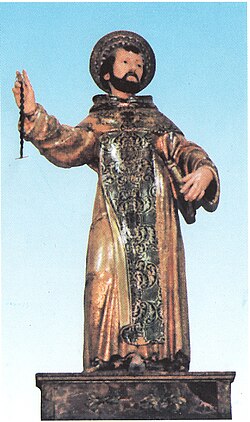St Leonard
| Saint Leonard of Noblac | |
|---|---|
 |
|
| Wooden statue of Saint Leonard, Abbot of Noblac | |
| Born | 19 May |
| Died | 559 AD |
| Venerated in |
Roman Catholic Church Eastern Orthodox Church Anglican Church |
| Feast | November 6 |
| Attributes | depicted as an abbot holding chains, fetters or locks, or manacles. |
| Patronage | political prisoners, imprisoned people, prisoners of war, and captives, women in labour, as well as horses |
Leonard of Noblac (or of Limoges orde Noblet (Latin: Leonardus; also known as Lienard, Linhart, Leonhard, Léonard, Leonardo, Annard)) (died 559 AD), is a Frankish saint closely associated with the town and abbey of Saint-Léonard-de-Noblat, in Haute-Vienne, in the Limousin (region) of France.
According to the romance that accrued to his name, recorded in an 11th-century vita, Leonard was a Frankish noble in the court of Clovis I, founder of the Merovingian dynasty. He was converted to Christianity along with the king, at Christmas 496, by Saint Remigius, Bishop of Reims. Leonard asked Clovis to grant him personally the right to liberate prisoners whom he would find worthy of it, at any time.
Leonard secured the release of a number of prisoners, for whom he has become a patron saint, then, declining the offer of a bishopric— a prerogative of Merovingian nobles— he entered the monastery at Micy near Orléans, under the direction of Saint Mesmin and Saint Lie. Then, according to his legend, Leonard became a hermit in the forest of Limousin, where he gathered a number of followers. Through his prayers the queen of the Franks was safely delivered of a male child, and in recompense Leonard was given royal lands at Noblac, 21 km (13 mi) from Limoges. It is likely that the toponym was derived from the Latin family name Nobilius and the common Celtic element -ac, simply denoting a place. There he founded the abbey of Noblac, around which a village grew, named in his honour Saint-Léonard-de-Noblat.
...
Wikipedia
